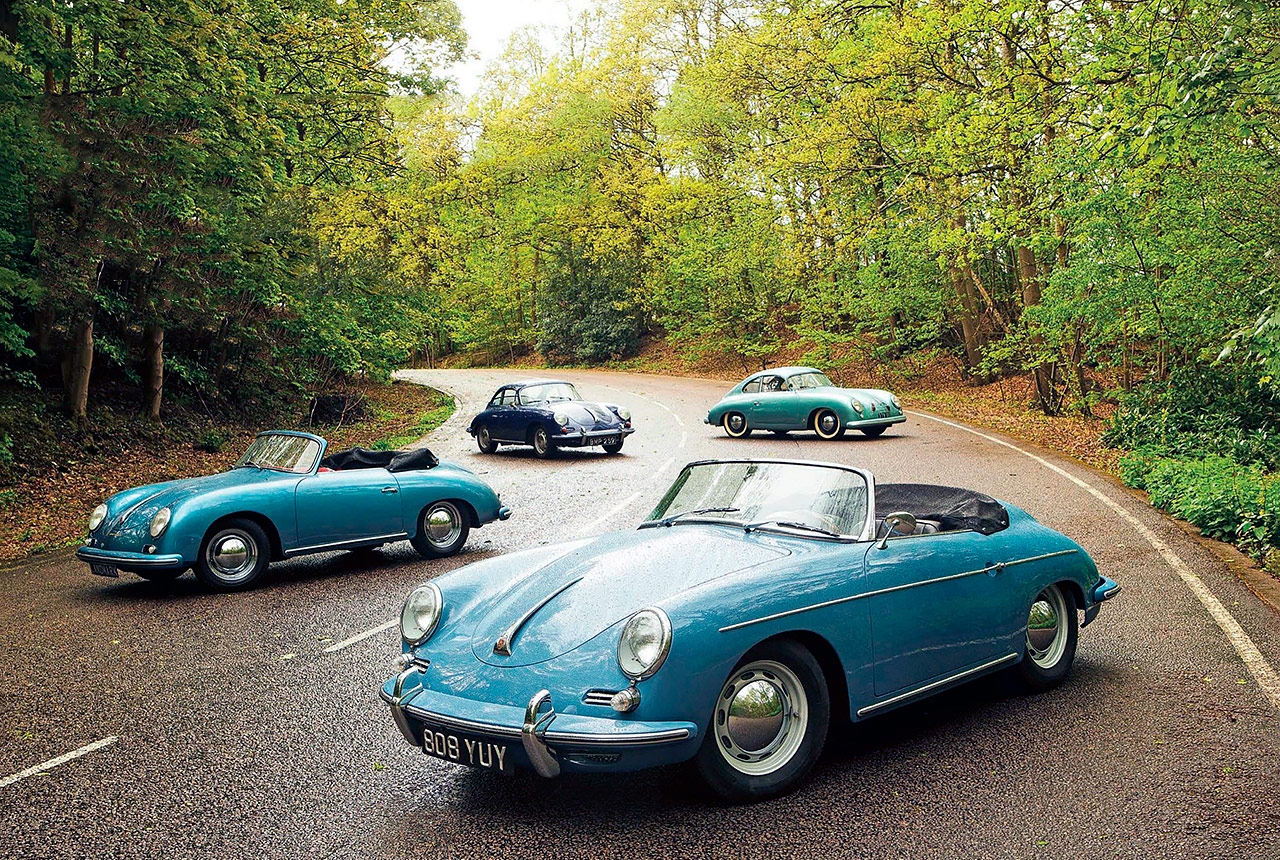
Pure Porsche – style and speed every sensational 356 tested: from Pre-A to C. Porsches amazing 356 hits the street. Stuttgart sensation from Pre-A to C we drive each variant of Porsches stunnig 356. Porsches Miracle. The sublime 356 defied post-war privations and family incarceration to reach production Ross Alkureishi samples the full set. Photography Tony Baker.
Don’t you envy talented families? Professor Ferdinand Porsche had already designed the Volkswagen during the 1930s but – like father, like son – it was his equally gifted offspring ‘Ferry’ who would produce the first road car to bear the clan’s surname. With the post-war Porsche team located in Gmiind, Austria, it embarked upon building a vehicle based on Volkswagen components. Into the mixing pot went Beetle design principles, as well as those of the Type 64 racers that were built for the 1939 Berlin-Rome race – which was cancelled due to the outbreak of WW2 – and the stillborn 1.5-litre, mid-engined Type 116.
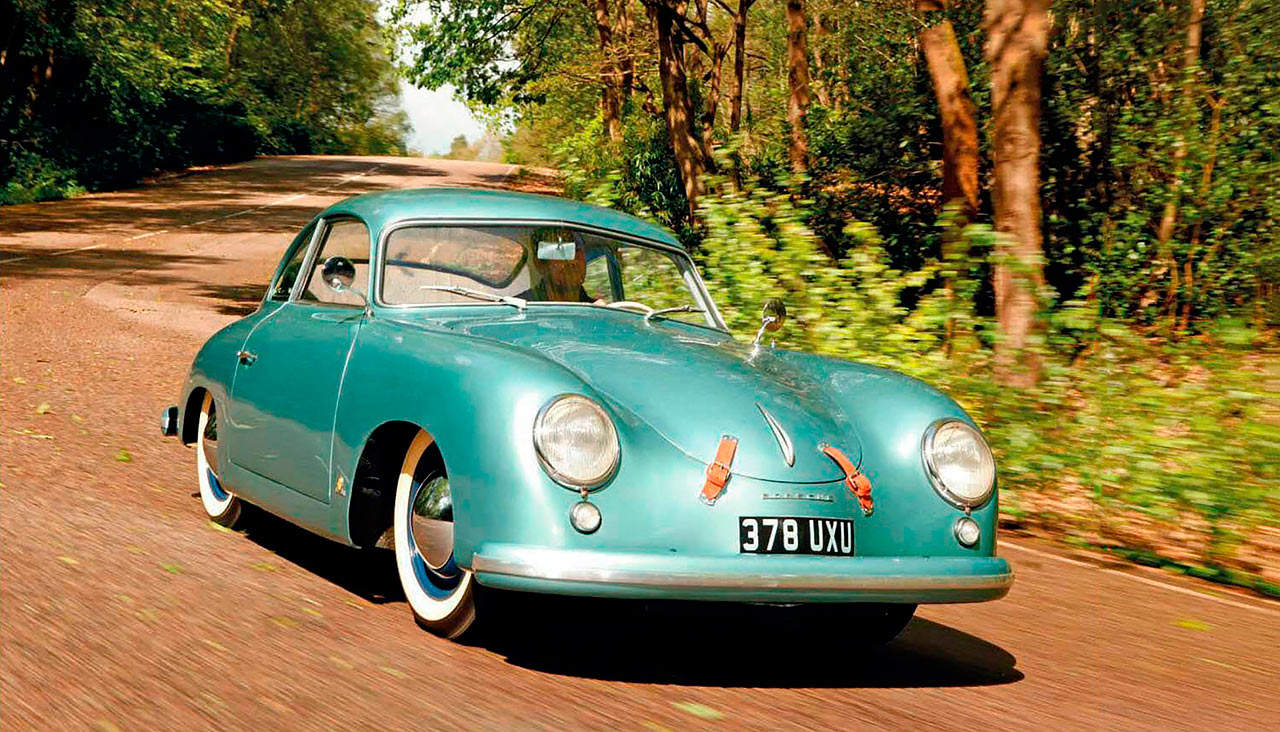
Left: gorgeous Pre-A features the purest styling – note ‘bent window’ rather than two- piece windscreen. Below: Porsche dash centrepiece; the earliest examples boasted solid wheels.
Given the designation Type 356, the prototype featured a spaceframe chassis with a modified 1131cc Volkswagen overhead-valve powerplant – up to 40bhp from the standard 25 – mounted amidships. Even though this engine position endowed the car with first-class handling, it took up too much space and caused problems locating the rear suspension.
Prototype 2 reverted to the traditional VW layout with the transaxle in front of the engine, creating a genuine 2+2. It also had a steel platform ‘chassis’ that was easier and cheaper to produce. Underneath the metal lay the familiar Wolfsburg-sourced brakes, worm-and-nut steering and independent suspension.
On its release in 1948, the 356 came with a 1086cc engine and a choice of either Coupe form or a drophead by Beuder of Switzerland, which built the prototype Cabriolet and the first six production cars. These Gmiind models, with their hand-beaten aluminium bodies, were bespoke vehicles, with production averaging around five per month. Post-war difficulties in sourcing supplies – plus a lack of both skilled labour and metal in the provincial backwater – meant that a return to Stuttgart was inevitable.
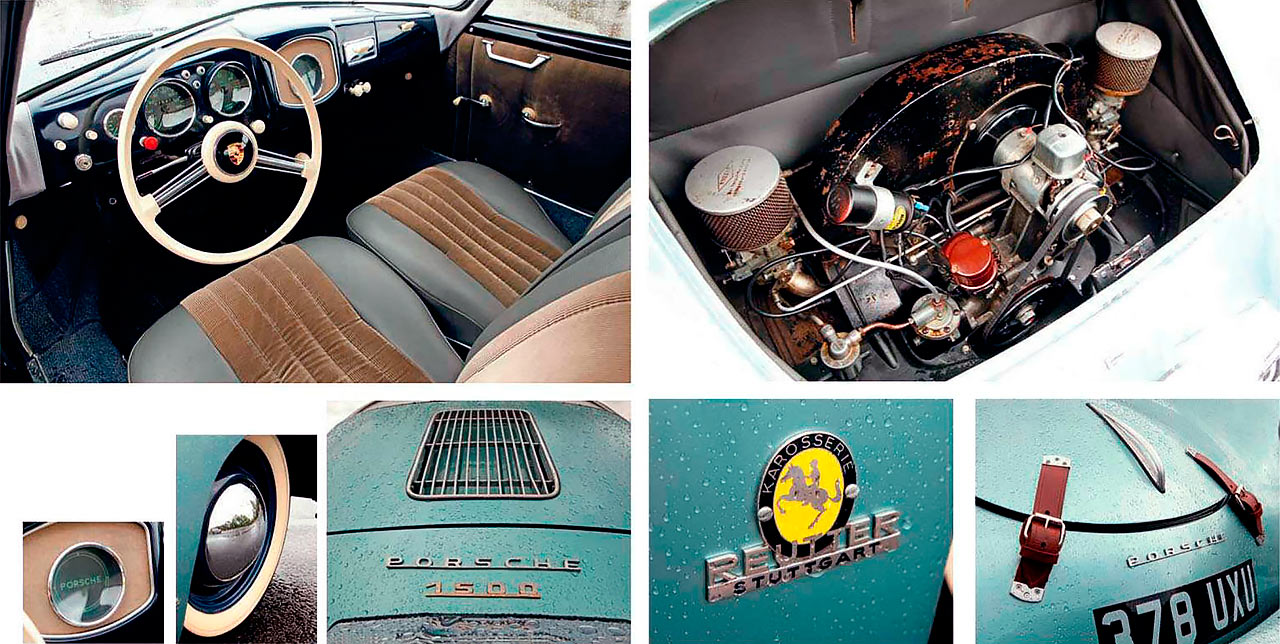
Clockwise: non-Super 60bhp engine; front panel straps; coachbuilder’s badge; 1500 was biggest Pre-A; stylish interior with 1953-on two-spoke wheel.
With demand soaring, production for 1950 switched to cheaper pressed-steel panels. The Reutter-made body was subdy wider and higher than that of its predecessor, and had fewer adornments. The following year heralded the arrival of the 44bhp 1.3-litre engine, with its pioneering chrome-dot lined aluminium cylinder bores. Then there was the roller-bearing, 55bhp 1.5-litre pushrod engine (later to become the 60bhp and then 70bhp Super thanks to a special camshaft and revised carburetion), plus uprated Porsche brakes.
The featured Pre-A Coupe is a 1953 car, and as such it has the one-piece – but still V-shaped – windscreen that was introduced the previous year, instead of the earlier two-piece affair. Presented in Adriablau, it has a haunting, ethereal quality. These early 356s are achingly pretty, and sport the purest aesthetics.
The driving position is comfortable, with the large ivory-coloured steering wheel and floor-mounted gearlever both being well sited. There is oodles of headroom, while in the rear you’ve the choice of using the seats for tiny passengers or flipping them forward to form a parcel shelf.
The 1.5-litre flat-four, here in non-Super guise, starts on the button and has an energetic, torquey nature. It’s worth bearing in mind that Porsche always quoted power in DIN bhp, so its 60bhp is more realistic than some. With just over 800kg to propel, it whisks you along with a pleasandy metronomic air-cooled thrum.
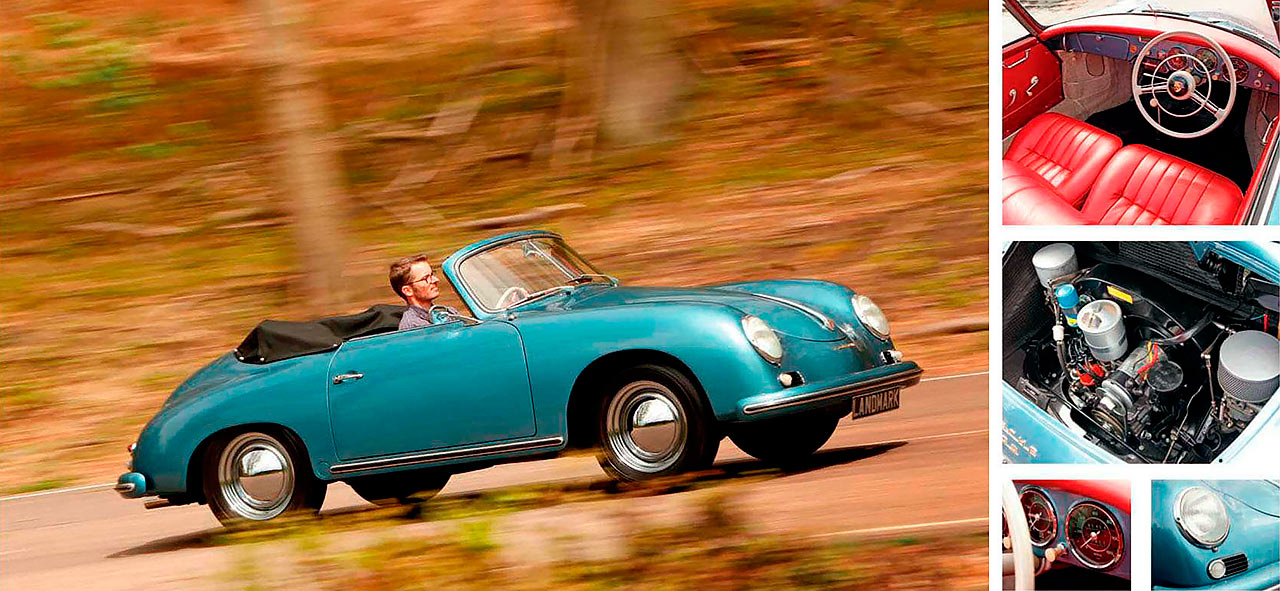
From top: rare right-hooker; Type 616/1 engine; revised dash with central tacho; A features front vents; handling is more benign than Pre-A.
It also has the improved Type 519 ’box with synchromesh on all four forward gears – carried from the competition cars and introduced in 1952. Due to its long lever and similar throws, it has you wondering whether or not it’ll ever find the ratio, but slots home perfectly every time.
With their tail-heavy nature and swing-axle rear suspension, 356s have a reputation for catching out the unwary. It’s worth tempering your enthusiasm – especially on the Pre-A’s skinny rubber – until you learn the model’s unique wischen, or ‘wiping’, technique for fast cornering. The car oversteers initially, but this can be countered via a delicate combination of steering input and throtde. Getting the balance right on these early cars requires practice and nerve – especially with current values – but once mastered you can safely savour just what a poised and precise little car it is.
Prior to the 1955 arrival of the 356A, the Pre-A variants housed 12 engine types – testament to the Porsche ethos of race-bred continual development – in four styles: Coupe, Cabriolet, America Roadster and Speedster. The updated car had a modified T-1 (Technische Program 1) body with a smoother roofline to house a new curved windscreen, one that was designed to come out in a head-on crash. Yet the biggest changes occurred out of sight, with comprehensive steering and suspension revisions.
The geometry of both was altered, and there was a thicker anti-roll bar, improved dampers – now vertically located, rather than inclined – and smaller, wider wheels. That all helped to provide friendlier cornering characteristics, but one side effect was increased kickback through the steering wheel, so a hydraulic damper was fitted to counter that.

Large overriders dominate B’s front end, but it’s still an alluring shape. Below: neat three-spoke wheel; unstressed damen powerplant; neat detailing.
Our 356A is thought to be one of only 56 right-hand-drive Cabriolets made. An open-top version had been available right from the very start of production – indeed, Prototype 1 had been made in that style, as were a total of eight Gmund examples. The body frame was comprehensively reinforced in the sill and floor areas to counteract the tin top’s removal.
This car has a Type 616/1 1600 engine producing 60bhp (the 75bhp 616/2 Super was also available), while in the lovely red leather- lined cabin there are supportive reclining seats by Reutter of Stuttgart, which would later market products under its Recaro brand. The roof is beautifully made and thickly padded, providing an excellent watertight seal – handy on a typical British day during which the weather is veering from the sublime to the ridiculous.
Lowering it is a one-handed manoeuvre and the result on the car’s character is distinct, both liberating a previously hidden mellifluous note to the flat-four’s soundtrack while eliminating the closed car’s light transmission-differential whine. There’s some scutde shake but not to a disconcerting level, and it’d put a number of cars from later decades to shame. There’s a clear improvement in terms of roadholding. The Pre-A’s aged origins never feel far from the surface, but the A doesn’t seem as rear-heavy or tail-happy. The wischen technique required here is more intuitive, but you still require an element of care when the road camber suddenly changes. One minor grumble is that the switch to right-hand drive means that there’s a tendency to trap your leg between the canted gearlever and the steering wheel when you cross the vast ocean between second and third ratios.
The 356 is sometimes derided as being a VW with a pretty face, but The Motor observed of the new model: ‘Of actual Volkswagen components there are now virtually none.’ As before, further development continued throughout the life of the A, including the introduction of the Carrera engine, teardrop tail-lights in 1957, an improved Type 644 transmission and a new T-2 body with the exhausts now neatly exiting via bumper overriders. As production numbers ramped up, however, the changes, while still regular, didn’t come quite as often.
In 1959, the T-5 bodied 356B arrived (Ts 3 and 4 never left the drawing board), with higher headlights, stronger bumpers and a handle on the bonnet. The 616/1 and 616/2 engines were carried over, with a new 90bhp Super unit available – Supers were now discernible by body script and Porsche emblems on the centre of their hubcaps. The line-up was Coupe, Cabriolet and the new-sounding Roadster.
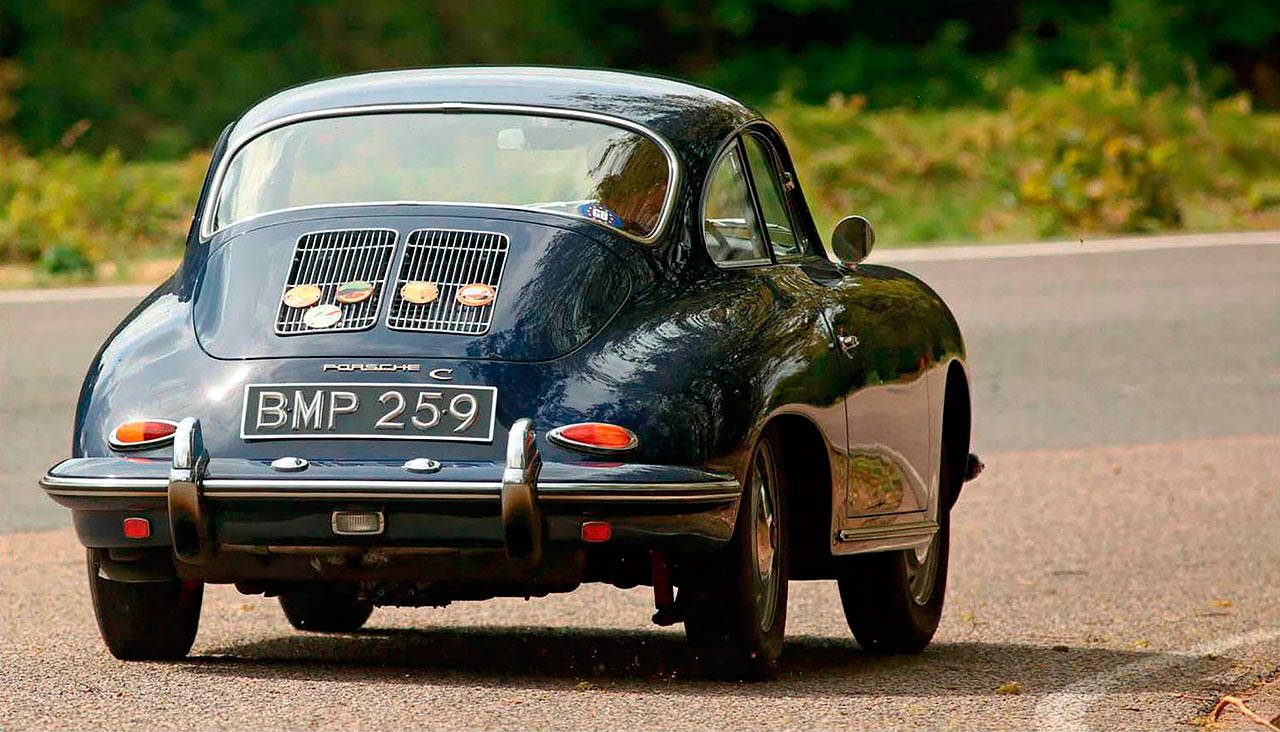
Left: the C carried over the T6 body that was used on the run-out B. Below: late engine performs better through entire rev range; disc brakes dictated a new design for the wheels.
In reality, the last of those was the latest in a line of stripped-out and sometimes hotted-up drop-tops that dated back to 1952. Unhappy with the 356’s looks, US importer Max Hoffman had approached artist Coby Whitmore and the result was the Type 540 America Roadster. Featuring alloy panels and a spartan cockpit, plus a 70bhp engine, most immediately went racing. Just 15 aluminium America Roadsters and one steel-bodied example were built, so they are among the rarest of all 356s.
The now iconic Speedster followed two years later in ’1954. In effect a stripped-out lightweight special based on the Cabriolet, it had minimal equipment including a cut-down windscreen, a flimsy hood and detachable sidescreens.
As the budget model in the range – $2995 against a 1500 Coupe’s $3445 and a 1500S at $4284 – it offered serious performance at a vastly reduced cost, but to the detriment of comfort.
By ’1958, it was clear that the Speedster needed replacing because sales had stalled. It was superseded by the Speedster D – quickly renamed the Convertible D – with body production switching from Reutter to Drauz of Heilbronn. This new model had an improved hood, taller windscreen, padded seats, wind-up windows and, most importantly for Porsche, a higher profit margin.
‘LOWERING THE ROOF LIBERATES A HIDDEN MELLIFLUOUS NOTE TO THE SOUNDTRACK’
All of which leads us to its 356B successor, in this case David Foster’s 1960 Aetna Blue Roadster. In the metal – with its larger bumpers and slighdy more bulbous bodywork – it’s lost a little of the earlier cars’ subdety, but its rakish roofline still endows it with most of that Speedster- derived sense of cool. Crucially, thanks to those bumpers, it’s the heaviest car here.
The cabin is strictly for two and has the B’s black detailing, albeit with the optional wood- rimmed steering wheel, which is a little plain compared to the white 1950’s glam of the previous two cars. Unlike the Speedster’s convertible top, which was a sop to keeping your hair dry and of no real use over 60mph, the Roadster’s is much improved, while the windscreen is detachable should you wish to go on-track.

Clockwise: the 75bhp unit was tuned for torque; unmistakable profile; badges adorn grille; door- mounted mirror; shorter gearlever in tweaked cabin.
Like the previous two cars, this has the less powerful damen unit, which doesn’t need to be worked as hard as the more peaky Super engines.
“It would seem to be a poor choice,” says Foster, “but after driving several early 356s, what you find is that these 60bhp engines are very torquey. Also, due to the cast-iron barrels for the pistons, as opposed to aluminium, they are very quiet. It’s a perfect relaxed touring vehicle.”
On the road, it offers a similar experience to the Cabriolet, but the body feels more rigid and the gearbox has much shorter throws plus a tighter gate. The low windscreen ensures that you drive it in semi-cartoon villain mode – shoulders 60% of the way to your ears – and it’s a little compromised in this gloriously wet country. As a stylish summer blaster, however, only its Speedster predecessor can pip it.
‘IT STILL REQUIRES A HIGH LEVEL OF SKILL, BUTTHECFEELSFAR MORE SURE-FOOTED’
A T6 body shape followed for the 1962 model year. Identifiable by its twin grilles on the engine cover and air intake louvres on the front scuttle, it would remain the same when the 356C iteration appeared two years later. Once again, and despite the looming presence of the 911, Porsche pressed on with development. In came new engines formulated by Hans Mezger – the 75bhp 616/15 for the 1600C, and the 95bhp 616/16 for the 1600SC – plus disc brakes and modified suspension.
The Motor wrote of the new model: ‘The layout is the same, but the development has refined it to a peak which has made it a car for the selective.’
The Sporting Motorist concurred, stating: ‘During its decade and a half of steady refinement, the Porsche has changed from a crude but effective roadgoing competition car to a well- behaved docile grand tourer in the real sense of the word.’ With John Liles’ 1600C Coupe still basking in the afterglow of those words, it’s time to take this last-of-the-line 356 for a spin.
It’s immediately clear that, as it should be, the C is the most sophisticated car here. As with the others, the engine is the entry-level unit but, at 75bhp, it’s also the most powerful in our group. The disc brakes are strong and negate some of the need for the pre-planning necessary in the other cars, while the handling characteristics of those early models have been almost completely tamed. It still requires a high degree of skill on the limit, but it seems far more sure-footed. It may feel softer and not quite as raw, but it remains a stunning driver’s car.
Ultimately, the 911 would become the defining Porsche but it’s the delectable 356 that cemented the company’s reputation for precision engineering. Despite the underlying design remaining pretty much unchanged throughout production, its constant development and the range of body styles ensure that there’s a real depth of variety within its world.
From beautiful Pre-A, chic Cabriolet and iiber-cool Speedsters, through to wild Carreras and smooth Cs, the choice is yours.
Thanks to the owners; DK Engineering: www.dkeng.co.uk; Landmark Cars: www.landmarkcars.co.uk; Andy Prill: www.prillporscheclassics.com; Porsche Club GB: www.porscheclubgb.com; Die Deutschen Klassiker: www.ddk-online.com; and Pete Trill
TECHNICAL DATA FILE
[tabs style=”flat-light”][tab title=”356 PRE-A”]
Sold/number built 1948-‘1955/7627
Construction pressed steel platform with pressed steel panels
Engine all-alloy, air-cooled, overhead-valve 1086/1286/1290/1488cc flat-four, twin Solex carburettors
Max power 40bhp @ 4200rpm – 70bhp @ 5000rpm
Max torque 52lb ft @ 2800rpm -108lb ft @ 3600rpm
Transmission four-speed manual, driving rear wheels
Suspension independent, at front by double trailing arms, laminated transverse torsion bars, anti-roll bar rear swing axles, laminated torsion bars; telescopic dampers f/r (lever-arms rear to April ‘1951)
Steering worm and roller
Brakes drums all round
Length 12ft 11 in (3937mm)
Width 5ft 5¾ in (1661mm)
Height 4ft 3 ¼in (1302mm)
Wheelbase 6ft 11 in (2108mm)
Weight 1697-1782lb (770-808kg)
0-60mph 17 secs (1500 Coupe)
Top speed 99mph (1500 Coupe)
Mpg 29
Price new £1971 (1500 Coupe, 1953 UK)
Price now £130,000-£260,000+
[/tab] [tab title=”356A (where different)”]
Sold/number built 1955-‘1959/21,045
Engine 1290/1582cc ohv or 1498cc dohc, twin Solex/Zenith/Weber carburettors
Max power 44bhp @ 4200rpm – 115bhp @ 6500rpm
Max torque 60lb ft @ 2800rpm – 91lbft @ 5200rpm
Weight 1675-2094lb (760-950kg)
0-60mph 16.5 secs (1600 Coupe)
Top speed 99mph (1600 Coupe)
Price new £1958 (1600 Coupe, 1957 UK)
Price now £50,000-£300,000+ (exc Carrera 2017)
[/tab] [tab title=”356B (where different)”]
Sold/number built 1959-‘1963/30,963
Engine 1582/1588cc ohv or 1966 dohc, twin Solex/Zenith/Weber carburettors
Max power 60bhp @ 4500rpm – 130bhp @ 6200rpm
Max torque 81lb ft @ 2800rpm – 119lb ft @ 4600rpm
Weight 1918-2226lb (870-1010kg)
0-60mph 15 secs (1600 Super)
Top speed 108mph (1600 Super)
Price new £2098 (Coupe, 1960 UK)
Price now £30,000-£160,000 (exc Carrera 2017)
[/tab]
[tab title=”356C (where different)”]
Sold/number built 1963-‘1966/16,678
Engine 1582cc ohv or 1966 dohc,
twin Solex/Zenith carburettors
Max power 75bhp @ 5200rpm- 130bhp @ 6200rpm
Max torque 90lb ft @ 3600rpm- 119lb ft @ 4600rpm
Brakes discs all round
Weight 2061-2226lb (935-1010kg)
0-60mph 14 secs (1600 Coupe)
Top speed 108mph (1600 Coupe)
Price new £2277 (1600 Coupe, 1964 UK)
Price now £35,000-£180,000 (exc Carrera 2017)
[/tab]
[/tabs]
THE SPECIALIST Andy Prill
“Mechanically they’re not that complicated unless you get into a Carrera, so most of the risk is in making sure the body is good. There’s a lot of shape in a 356, and on badly restored cars that’s what lets them down.
If you get that wrong it can become very costly. A body restoration, including paint, starts at £30,000 and can rise to £100,000.

Andy Prill Porsche 356 specialist
“Open cars lose a lot of rigidity despite having reinforced sills and floors, so it’s even more important that the overall body structure is strong.
“Other than that, it’s all the normal checks. It’s basically VW suspension that was redesigned by Porsche. Engines can be expensive to rebuild, and range from £6500 to £10,000 for an ‘as new’ unit.
“There are very few Gmund cars around and they change hands for exorbitant sums. Speedsters are the most desirable body shape, and Cabriolets are more sought after than Coupes. No matter what model it is, look at provenance, history and bills. If you’re in any doubt, have it inspected by someone who knows these cars”
The Carrera
In 1953, a 550 Coupe and a 356 achieved a one-two class finish on the Carrera Panamericana.This prompted the design of the Type-547 engine and the adoption of the Carrera name for its most powerful 356.
Dr Ernst Fuhrmann’s 1.5-litre unit had twin-overhead camshafts per bank, two plugs per cylinder and dry- sump lubrication. The race version was good for 112bhp and the production 1500GS Carrera had 100bhp.
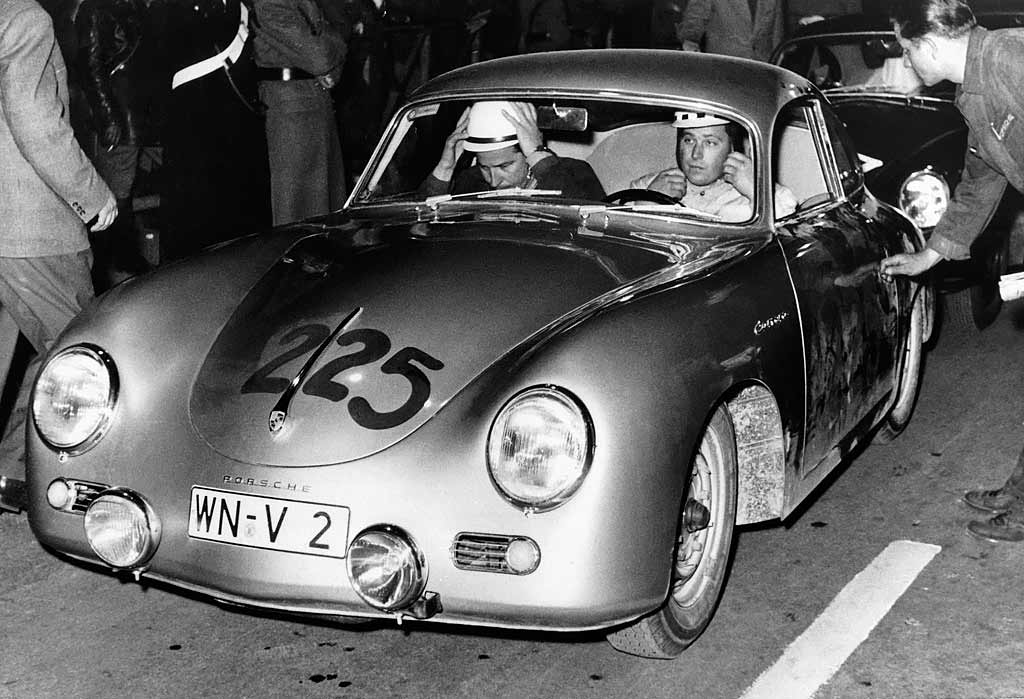
1957 Porsche 356A/1500GS Carrera GT Coupé
In 1957, two versions became available: a deluxe GS and race-orientated GT – the latter in only Speedster or Coupe forms. Capacity was increased to 1587cc in 1958, with a plain-bearing crank, and road car power was upped to 115bhp.
The 1962 Carrera 2 had a 130bhp 1966cc engine fed by twin Solex carbs. In the States, twin Webers were used, the GS giving 140bhp and the GT 155bhp. The ultimate development is the B Carrera 2 GT with a slightly detuned 904 engine and 180bhp. Today, the GS starts at £450,000 with Speedster GTs north of £1 million.
CLUB
{module Porsche 356}





